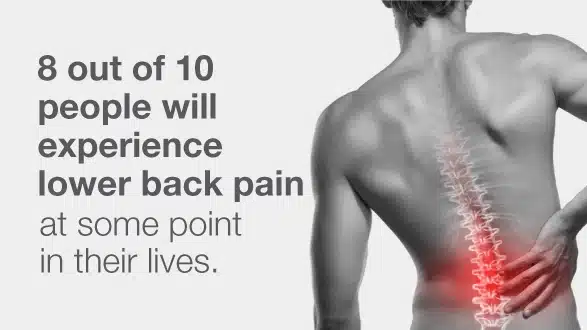Request Appointment
Enter your details and we will be in touch with you shortly;
Or call
8655885566
between 8 am and 8 pm.

Pain in lower back that is often accompanied by radiating hip and leg pain

Lower back pain or ‘Lumbago’ pain comes from muscle strain, tension or injury in the lower back, usually affecting the bones, discs, nerves, or spine muscles. The lumbar spine (lower back) is very prone to injury. Timely lower back pain treatment is essential to reduce discomfort and prevent long-term complications. Symptoms vary depending upon the injury sustained by the muscles, ligaments, discs, joints, or vertebrae. But the most common ones are:
Get immediate medical care if:
These symptoms could indicate a deeper issue.
Lower back pain is one of the leading causes of disability worldwide. The lower back or lumbar spine provides support, strength, and flexibility while performing various activities of daily living. Muscles around the spine help in maintaining the spinal alignment and also offload the extra stress it bears. Lower back pain comes with its disabling effects on the human body when not taken care of. Hence, it becomes really important to get it treated in time.
Recognizing the symptom patterns early can help guide you toward seeking lower back pain treatment and further evaluation. An initial assessment focused on your symptom history is often the first step before considering any lower back pain therapy options. With early detection, you can work with your healthcare provider to monitor your condition and decide if additional interventions are necessary. This proactive approach forms the cornerstone of effective lower back pain relief therapy, paving the way for a timely lower back pain relief treatment plan that minimizes further complications.
 Professional diagnosis required
Professional diagnosis required Chronic, can last for years
Chronic, can last for years Treatable with 4 weeks of QI Spine Therapy
Treatable with 4 weeks of QI Spine TherapyLumbago pain is the most common type of back pain and occurs because of either mechanical or non-mechanical causes.
Most Lower Back Pain is mechanical in nature, i.e., it originates in the soft muscle tissue that supports the spine. A Spine Function Test, like the Digital Spine Analysis, may be recommended to identify and isolate the pain area.
In many situations, lower back pain is not due to any serious evolving medical conditions. Most of the time, it stems from relaxed daily activity or muscle and spine strain for a brief period. Here are the following short-term causes:
 Professional diagnosis required
Professional diagnosis required Chronic, can last for years
Chronic, can last for years Treatable with 4 weeks of QI Spine Therapy
Treatable with 4 weeks of QI Spine TherapyThe most important thing about back pain is an accurate and timely diagnosis. Once that’s done:
Every back pain case is different, and so is the treatment for it. If left untreated, it can get worse over time. It is best that you consult a spine doctor as soon as pain symptoms appear.
The pain that is associated with the lower back is manageable, and the best approach is to engage the use of the medical approach as well as incorporate natural remedies. A key element in recovery is lower back physical therapy, which focuses on strengthening core muscles, improving flexibility, and enhancing stability. A structured physical therapy programme depends on the case being treated and most times acts as the long-term component regarding the treatment of pain.
Many patients find that alternating between heat and cold therapy helps alleviate discomfort and reduce inflammation. Heat helps to ease the tensed muscles and on the other hand, cold is effective in reducing the size of the muscles.
For severe pain, some doctors may recommend epidural steroid injections to reduce inflammation around the nerve roots, providing temporary relief during the healing process.
When pain is persistent, muscle relaxants for back pain may be prescribed as part of a comprehensive treatment plan to ease muscle spasms, making it easier to participate in rehabilitative exercises.
Alternative treatments such as acupuncture for lower back pain are gaining popularity due to their potential to stimulate the body’s natural healing response without the side effects sometimes associated with medications.
A combination of pain management techniques—including mindfulness, controlled breathing, and guided physical exercises—can significantly improve quality of life. Integrating posture correction exercises into daily routines ensures that the spine is well-supported during all activities. Also, some patients explore inversion therapy for back pain as a way to decompress the spine, though this should be undertaken with professional guidance.
Altogether, these interventions form a single systematic approach that targets the decrease of discomfort, long-term backbone health, and enhanced quality of life.
QI Spine has adopted a patient-oriented model of care starting with diagnostic services and relevant clinical assessment procedures. It enables us to discover the fundamental cause of the lower back pain; therefore, every therapy given will be of necessity specific not only to the patient but more to the condition he or she has.
For patients who may be in severe pain during a particular period, there are several ways of handling the situation without any invasive measures. In ideal targets, there might be the use of specific pain killers and guided physiotherapy stretching as well as temperature applications, hot packs, and cold packs. These interventions are designed to provide rapid Lumbar pain relief while reducing inflammation and muscle tension.
An important point of the approach is the combination of the FSM treatment – cell repair technology that helps with tissue healing and prevents or mitigates inflammation. This approach is seamlessly integrated with traditional rehabilitation methods, offering effective non-surgical back pain solutions that help many patients avoid the need for surgery.
This individualized approach also covers a musculoskeletal system rebuilding plan involving a various range of therapies to help manage spinal issues of the patient.
In some cases, patients may also benefit from chiropractic adjustments, which further optimize spinal alignment and contribute to overall pain reduction.
You can very well avoid or prevent low back pain with the following simple, self-help strategies, which can also be effective in preventing the recurrence of back pain.
You should seek medical care if you face the following signs: -
 Professional diagnosis required
Professional diagnosis required Chronic, can last for years
Chronic, can last for years Treatable with 4 weeks of QI Spine Therapy
Treatable with 4 weeks of QI Spine TherapyThe most important thing about back pain is an accurate and timely diagnosis. Once that’s done:
Every back pain case is different and so is the treatment for it. If left untreated it can get worse over time. It is best you consult a spine specialist as soon as pain symptoms appear.
 Professional diagnosis required
Professional diagnosis required Chronic, can last for years
Chronic, can last for years Treatable with 4 weeks of QI Spine Therapy
Treatable with 4 weeks of QI Spine TherapyThe most important aspect of treating lower back pain is obtaining an accurate diagnosis that pinpoints the underlying cause of lower back pain.
For an accurate diagnosis, your physician may ask for your medical history and a detailed description of your symptoms. You will be asked about the current symptoms, posture, activity level, and recent injuries.
The doctor will also conduct a thorough examination, which includes neurological and musculoskeletal examination.
If the cause of lower back pain is still unclear or more information is needed, then you may be asked to get a few imaging tests done. Common imaging tests are: -
At QI Spine, the diagnosis is done by asking the patient’s history, conducting a thorough physical examination, and doing DSA (Digital Spine Analysis test), which helps in analyzing the root cause of the problem. It is a non-invasive functional test that helps in measuring spine function. Its controlled and guided movements help in determining the mobility of the spine, strength, and imbalances of muscles around the spine.
 Professional diagnosis required
Professional diagnosis required Chronic, can last for years
Chronic, can last for years Treatable with 4 weeks of QI Spine Therapy
Treatable with 4 weeks of QI Spine Therapy






Have a question?
Ask our spine specialists
Who is a QI Spine Specialist?
A QI Spine Specialist is a medical expert with

Dr. Nidhi Sanghvi Shah

Dr. Shital Gaikwad

Dr. Richa Bhatia
9000 hours
of specialisation in treating back and neck conditions
32 hours
of spine physiotherapy specialisation methods in McKenzie concepts, Kinetic control, Neurodynamic solutions, Mulligan’s concepts
500 hours
and 6 months of QI Spine specialisation courses
Incorporate core strengthening exercises and gentle stretches designed for spine alignment therapy into your routine. Specific lower back physical therapy routines, including exercises like pelvic tilts, glute bridges, and knee-to-chest stretches, can be helpful.
For immediate symptom control, non-surgical approaches such as lower back pain treatment combined with heat and cold therapy are very effective. Targeted interventions like muscle relaxants for back pain and posture correction exercises like hip flexor stretches, cat-cow, child’s pose, etc.
It is for these reasons that various pain therapy programs may be given to women to address such common discomforts as lower back pain that is occasioned by hormonal fluctuations, pregnancy, and bad posture, among other causes. Customized exercise regimens along with posture correction exercises can help manage pain and promote lumbar pain relief.
At early stages of pregnancy, it could be due to a shift in posture and weight change, making it difficult to carry out daily activities. A combination of lower back pain relief treatment and pregnancy-safe exercise like walking, swimming, prenatal yoga, Pilates, and stationary cycling.
Usually, low back pain gets resolved on its own within 1 or 2 weeks. But, if it doesn’t improve, you should get it treated with the help of a spine specialist.
Running or jogging worsens the pain. Consult your physician before doing such an activity.
Sometimes, it may not be possible to pinpoint the root cause of pain. However, many reasons like bad posture, lifestyle habits, or injuries might cause low back pain.
The best sleeping position while having lower back pain is on our side with partial bending of the knees. Keeping your knees bent will help balance the body and reduce pressure on the lumbar spine. You can also keep a small pillow between your knees.
You should consider walking as it’s a low-impact aerobic exercise and may help in reducing low back pain. But, if walking is one of the aggravating factors of your pain, it should be avoided.
At times, lower back pain may be related to cancer. It is one of the first symptoms of cancer and you should be cautious if you face additional symptoms such as fever, sudden weight loss, or neurological symptoms along with low back pain.
Back pain is related to barometric pressure and outdoor temperature. In general, muscles and joints react to the environment, which can make them stiff. Also, pressure changes can cause joint pain.
Major lifestyle factors that may alter the chances of developing low back pain are obesity, smoking, lack of physical activity, poor posture.
Practicing specific asanas or poses may help in relieving you from lower back pain. Yoga helps in improving the flexibility of muscles. It also improves posture. Breathing exercises can relieve stress. Check with your physician to know the asanas that benefit you in providing lower back pain relief.